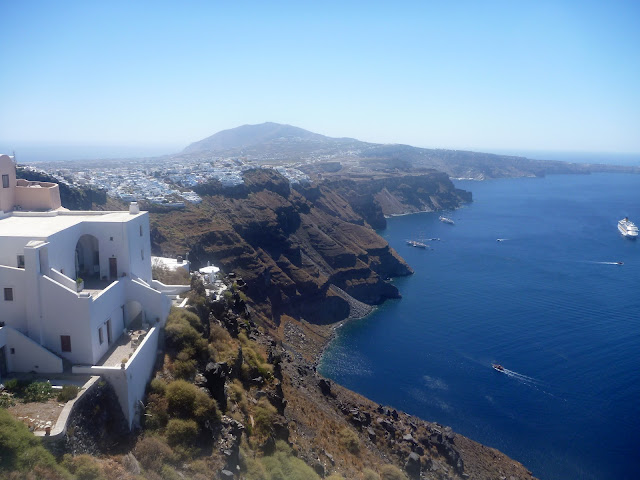the path runs along the coast on top of the cliff. Unlike the usual flagstones you get in the Cyclades, this path is paved with pieces of lava
and the views are spectacular
zooming in on this gorgeous boat
Palaia Kameni and Nea Kamaini at our feet
Phera in the distance. Most of Cycladic villages and towns are built on steep hills
and consequently, there are steps everywhere.
The houses resemble connected stak-white cubes with rounded edges, forming a compact mass and are irregularly aligned. They are built next and on top of each other. They have walls that subtly slant out towards the ground to give the impression that the building is growing out of the island's rocky ground. The streets are a maze of paved narrow alleys that are characterised by white-washed outlined flagstones and they connect the houses like dots on a map.
As we walked along we had houses on your left
roofs on our right
and there was always a church ahead.
and inclined.
Simple, clean, organic lines
white pebbles on the roof to add to the aesthetic
There are fields on either side of this wall which is between the villages of Merovigli and Phirostephani, so we walked on
Skaros, the lone rock between the two villages, Merovigli and Phirostephani has steep, narrow steps that lead to its summit.
Some of the grander houses have courtyards
the windows are small to protect from the strong winds. The doors and windows are painted in cobald blue, reflecting the blue of the sea and the sky, producing beautiful contrasts with the stark white of the houses. This shade of blue is also used on the domes of many of the churches.
beautifully positioned - just so
three chimneys - the residents have a real problem with tourists stepping on their roofs to look at the view and take photographs
The style derives from the exceptional style of Cycladic art that flourished between 2000 and 3000 BC
and has characterised the region since. The drive for minimalist interiors and exteriors that characterises our age could be seen as a derivative of this architecture
down to the grey that is so fashionable at the moment.
Phera is just round the corner
two sets of steps: the houses have exterior staircases that connect the lower to the upper floors of the houses.
The art of simplicity. Mies van der Rohe famously said 'less is more' and this certainly applies here
these undulating walls!
This very small church heralds our entry to Phera
one last look at the drama of that view.






























No comments:
Post a Comment